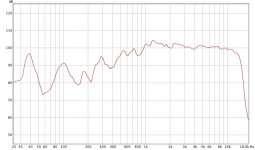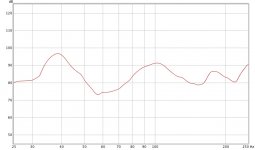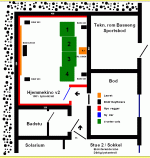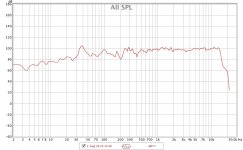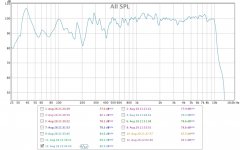Hi guys 
Not sure where to post this, didnt find a specific category to use Moderator - feel free to move if needed
Moderator - feel free to move if needed 
I have earlier this summer completed my line array DIY-project and just now been able to do freq.sweeps and get measurements. Ref the two freq. graphs.
Freq. taper off from 500hz mainly due to the un-EQ'd frequency responce from the LA but my main consern in this regard is the dips.
Is it my room? (Untreated acousticly, concrete walls/ceiling and 2x2" wood frame work and gypsum plated walls.) Room is approx 20x14ft with 7,5ft floor2ceiling height.
Measurement is taken from the left LA only, non-EQ'd at listening distance (~9ft)
If different measurements need to be taken let me know and I'll get it done
What do you guys read from it?
Not sure where to post this, didnt find a specific category to use
I have earlier this summer completed my line array DIY-project and just now been able to do freq.sweeps and get measurements. Ref the two freq. graphs.
Freq. taper off from 500hz mainly due to the un-EQ'd frequency responce from the LA but my main consern in this regard is the dips.
Is it my room? (Untreated acousticly, concrete walls/ceiling and 2x2" wood frame work and gypsum plated walls.) Room is approx 20x14ft with 7,5ft floor2ceiling height.
Measurement is taken from the left LA only, non-EQ'd at listening distance (~9ft)
If different measurements need to be taken let me know and I'll get it done
What do you guys read from it?
Attachments
Last edited:
My reasoning was since I wanted a reading on how the array performed I didnt want to complicate it with the pair. I am considering a TL-addition for low end support. However for what I am asking here a single array might not be ideal as a baseline  Thats for being an acoustic iliterate
Thats for being an acoustic iliterate 
but my main consern in this regard is the dips.
Is it my room? (Untreated acousticly, concrete walls/ceiling and 2x2" wood frame work and gypsum plated walls.) Room is approx 20x14ft with 7,5ft floor2ceiling height.
Welcome to the real world. What was it you were expecting? Rooms always add peaks and dips in the low frequencies. If it bothers you, build some bass traps. You could also use EQ, but it may only help one spot in the room.
In my view, the main issue that needs to be corrected is the uncompensated baffle step. I couldn't listen to that response as is.
I should mention I used to live with a concrete room very close to the same size. Really, you will need room treatment. There's no getting around it. Is the floor wood? Do you have carpet? I suggest ceiling tiles for the ceiling, at least a 2 or 3 panel traps for the walls.
Welcome to the real world. What was it you were expecting? Rooms always add peaks and dips in the low frequencies. If it bothers you, build some bass traps. You could also use EQ, but it may only help one spot in the room.
In my view, the main issue that needs to be corrected is the uncompensated baffle step. I couldn't listen to that response as is.
I wasnt expexting nothing special, I wanted to learn what is showing up in the data collected. Interpret and form a path in a sense.
The graph is from non-EQ'd testing since I didnt want to color any baseline data. I am using an Ashly 15band EQ adjusting the signal to taste when playing music/watch movies.
Floor is wooden tiles and the array cover about 85% of floor2ceiling distance.
Prior to my thread I knew the room would benefit from acoustic treatment (which room doesnt) but knowing how much and where is were I want to learn more about
I'm sorry, but I fail to see the point.
You are not going to listen to your arrays outside, right?
So why would you want to test them outside?
You will be listening to them in that room, so you have to test them in a real-world situation that is important for you.
Adding furniture, decorations, then room treatment like bass traps and acoustic panels will help, along with an EQ suited for the room.
You are not going to listen to your arrays outside, right?
So why would you want to test them outside?
You will be listening to them in that room, so you have to test them in a real-world situation that is important for you.
Adding furniture, decorations, then room treatment like bass traps and acoustic panels will help, along with an EQ suited for the room.
So what's plainly evident is as Greg mentions, the effects of a lack of baffle step. The response from 1khz up goes unappreciated........it's pretty fantastic really.
So first a passive full BSC network is needed to to offset the rising response above 1khz.
Your measured response matches Martin Kings formula where baffle losses begin at 4560/baffle within inches. So if we assume a 4.25" baffle for your TC9 array, we find the losses begin at 1khz and you will need full 6db compensation.
First, you'll need a Zobel circuit to flatten the impedance and then the BSC tilt.
See here for some help
http://www.quarter-wave.com/General/BSC_Sizing.pdf
So first a passive full BSC network is needed to to offset the rising response above 1khz.
Your measured response matches Martin Kings formula where baffle losses begin at 4560/baffle within inches. So if we assume a 4.25" baffle for your TC9 array, we find the losses begin at 1khz and you will need full 6db compensation.
First, you'll need a Zobel circuit to flatten the impedance and then the BSC tilt.
See here for some help
http://www.quarter-wave.com/General/BSC_Sizing.pdf
I'm sorry, but I fail to see the point.
You are not going to listen to your arrays outside, right?
So why would you want to test them outside?
You will be listening to them in that room, so you have to test them in a real-world situation that is important for you.
Adding furniture, decorations, then room treatment like bass traps and acoustic panels will help, along with an EQ suited for the room.
Indeed, I know what you are saying Perceval, please allow me to elaborate on my thinking (not all related to this thread) :
1 - I am interested in the un-EQ'd response from the array as I am considering making a TL woofer for low end support. To do that I need to know the natural roll off of the array.
2 - Measuring outside would eliminate the room from that equation. I can then with greater precision tell "this does that" and "that does this"
3 - Not coloring the sound with EQ will give me the most "true" room response.
@Mayhem - thanks for the link and insight. The front baffle is 4-1/2" wide.
An analouge EQ-unit is used to counter the baffle step so that the sub 1kh region is lifted to match. I have not done readings of this yet due to limited time to play.
I am kind of surprised to see no distinct high frequency drop. Did you gate the measurement? Is the array in it's position near the wall? And at what distance did you measure? I'd also suggest measuring more than once in a few different places at about the same distance to see what it does with the peaks and valleys.
I'd do it the same as you though, measuring one array at the time.
I expected more output in the 100-400 range judging the EQ settings of the similar array from OPC:

That EQ graph shows a massive pull down at 160 Hz of 10 dB.
http://www.diyaudio.com/forums/multi-way/193015-stupid-cheap-line-array-7.html
I'd do it the same as you though, measuring one array at the time.
I expected more output in the 100-400 range judging the EQ settings of the similar array from OPC:

That EQ graph shows a massive pull down at 160 Hz of 10 dB.
http://www.diyaudio.com/forums/multi-way/193015-stupid-cheap-line-array-7.html
I am kind of surprised to see no distinct high frequency drop. Did you gate the measurement? Is the array in it's position near the wall? And at what distance did you measure? I'd also suggest measuring more than once in a few different places at about the same distance to see what it does with the peaks and valleys.
I'd do it the same as you though, measuring one array at the time.
I expected more output in the 100-400 range judging the EQ settings of the similar array from OPC:

That EQ graph shows a massive pull down at 160 Hz of 10 dB.
http://www.diyaudio.com/forums/multi-way/193015-stupid-cheap-line-array-7.html
If I understood the OP correctly, his posted measures are no eQ.....and if so, yes I agree I would have expected more of a drooping response up high. It looks almost too good to be true from 1khz on up! Makes me wanna go buy a case of small Fullrange drivers right now!
This is my sweep done with both arrays in my concrete rectangle of a listening room.
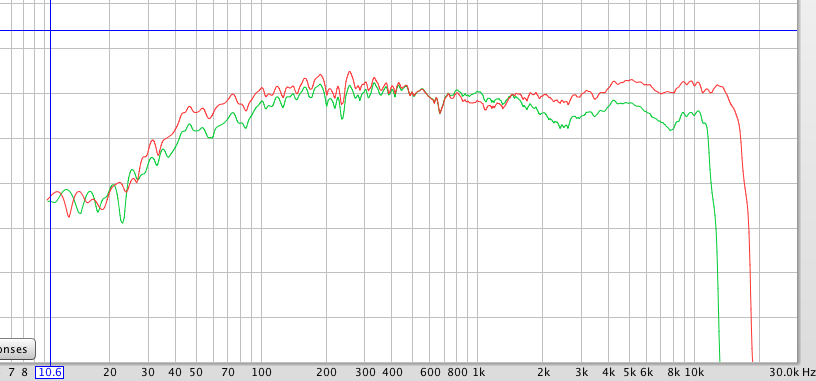
The green is without EQ, the red with an early attempt at EQ. Things moved on since, but it gives an idea.
I boosted some high end, and the dip, centered at 1k is intentional, I find it clears the music and singers have a less nasal tone.
Halair, I get what you are trying to do by going outside, but since you will not be playing them outside, it is a bit futile to find that one out. Even adding a sub, it will need to be tailored to your room, not the outside!
It's a DIY project, meaning it is good for you and your room requirements. Make them truly tailored to your needs and make them sing!

The green is without EQ, the red with an early attempt at EQ. Things moved on since, but it gives an idea.
I boosted some high end, and the dip, centered at 1k is intentional, I find it clears the music and singers have a less nasal tone.
Halair, I get what you are trying to do by going outside, but since you will not be playing them outside, it is a bit futile to find that one out. Even adding a sub, it will need to be tailored to your room, not the outside!
It's a DIY project, meaning it is good for you and your room requirements. Make them truly tailored to your needs and make them sing!
I actually think measuring them outside is a great idea if it is reasonably practical to move them out there. It will provide a baseline for the frequency response of the speaker system on it's own. That way you'll know what peaks/dips are from the room, and what's from the speaker. I'd assume the peak at ~39Hz and the dip at ~57Hz are room related, but it's good to know for sure.
IME concrete rooms really are tough to deal with. They are like a science demonstration in standing waves... The LA cylindrical dispersion will help in the mids and the highs, but IMHO bass traps are really the only way to smooth out the bass.
Another idea: OB subs are a pretty good option for concrete rooms, because of their figure 8 dispersion.
IME concrete rooms really are tough to deal with. They are like a science demonstration in standing waves... The LA cylindrical dispersion will help in the mids and the highs, but IMHO bass traps are really the only way to smooth out the bass.
Another idea: OB subs are a pretty good option for concrete rooms, because of their figure 8 dispersion.
Did you gate the measurement? Is the array in it's position near the wall? And at what distance did you measure? I'd also suggest measuring more than once in a few different places at about the same distance to see what it does with the peaks and valleys.
Gate? No.
About 90cm out from the wall (front baffle).
Speaker about 1,5m out from left side wall - 3,5m out from right wall.
Mic 2,5m out from middle speaker directly in front, mic pointing straight towards front baffle.
Hear ya on several sweeps from different angles
Warning: I might be totally wrong.
I used to use REW to adjust the room EQ. I did not get EqualizerAPO to work properly under Windows 8.1 and am now using Room EQ which does both jobs in one step.
Results are more to my liking and I've been pondering about this.
I might be mistaken but if you use REW then that measures the performance of your drivers because of the gating they use - in other words REW is trying to exclude the room response. Mathaudio imho takes into account the room response.
What I am trying to convey is that first you try to get your enclosures right with REW and once you've done as much as you could then afterwards use Mathaudio to see what that reports / wants to adjust the EQ to and start working on the room itself.
AM
I used to use REW to adjust the room EQ. I did not get EqualizerAPO to work properly under Windows 8.1 and am now using Room EQ which does both jobs in one step.
Results are more to my liking and I've been pondering about this.
I might be mistaken but if you use REW then that measures the performance of your drivers because of the gating they use - in other words REW is trying to exclude the room response. Mathaudio imho takes into account the room response.
What I am trying to convey is that first you try to get your enclosures right with REW and once you've done as much as you could then afterwards use Mathaudio to see what that reports / wants to adjust the EQ to and start working on the room itself.
AM
Last edited:
In their final position, will they be 90 cm out from the wall? Or actually closer to the wall.
I think that position could be partially responsible for the dips seen around 200 Hz and ~400 hz.
I expected them placed closer to the back wall in their final position to aid the low frequencies.
Still doesn't explain the lack of a drop in the higher frequencies though.
The EQ graph from OPC was with this placing (I believe):
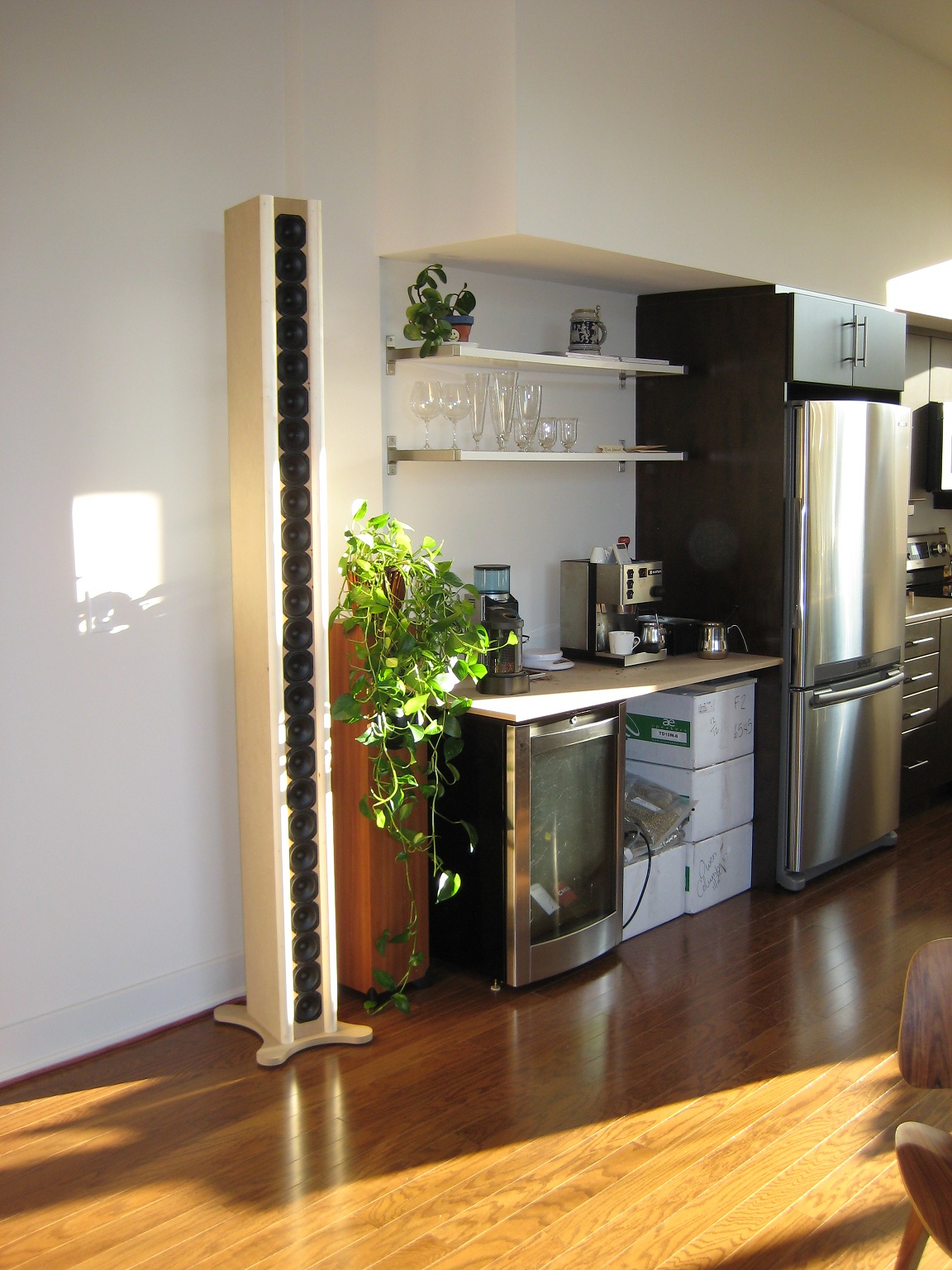
Another example from user: koldby

I think that position could be partially responsible for the dips seen around 200 Hz and ~400 hz.
I expected them placed closer to the back wall in their final position to aid the low frequencies.
Still doesn't explain the lack of a drop in the higher frequencies though.
The EQ graph from OPC was with this placing (I believe):

Another example from user: koldby

Last edited:
Here's the post with measurements in the listening position (after EQ)
http://www.diyaudio.com/forums/multi-way/193015-stupid-cheap-line-array-22.html#post2902178
http://www.diyaudio.com/forums/multi-way/193015-stupid-cheap-line-array-22.html#post2902178
- Status
- This old topic is closed. If you want to reopen this topic, contact a moderator using the "Report Post" button.
- Home
- General Interest
- Room Acoustics & Mods
- Room treatment - Full Range Line Array / REW measurement
